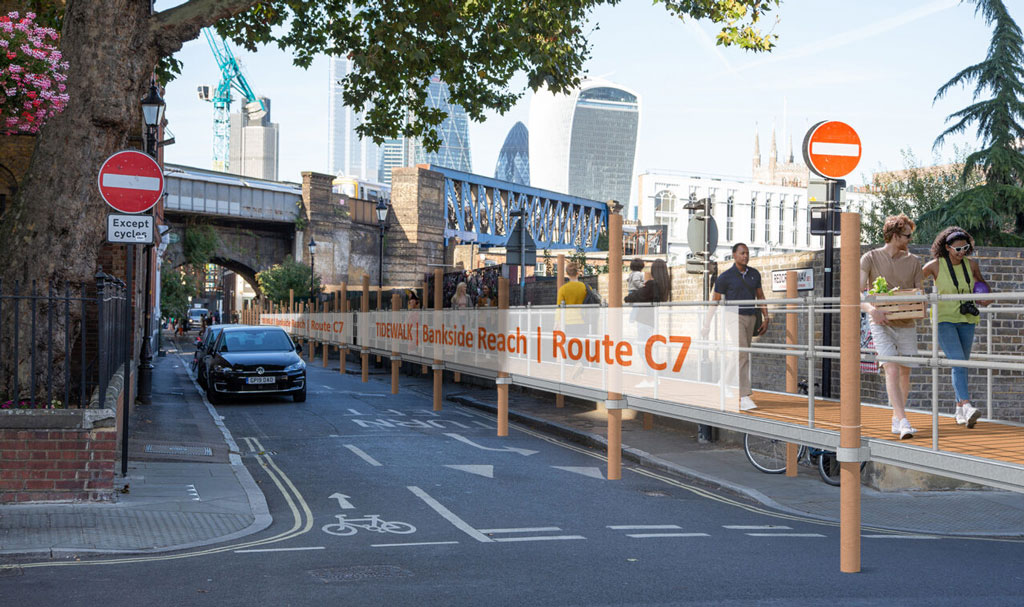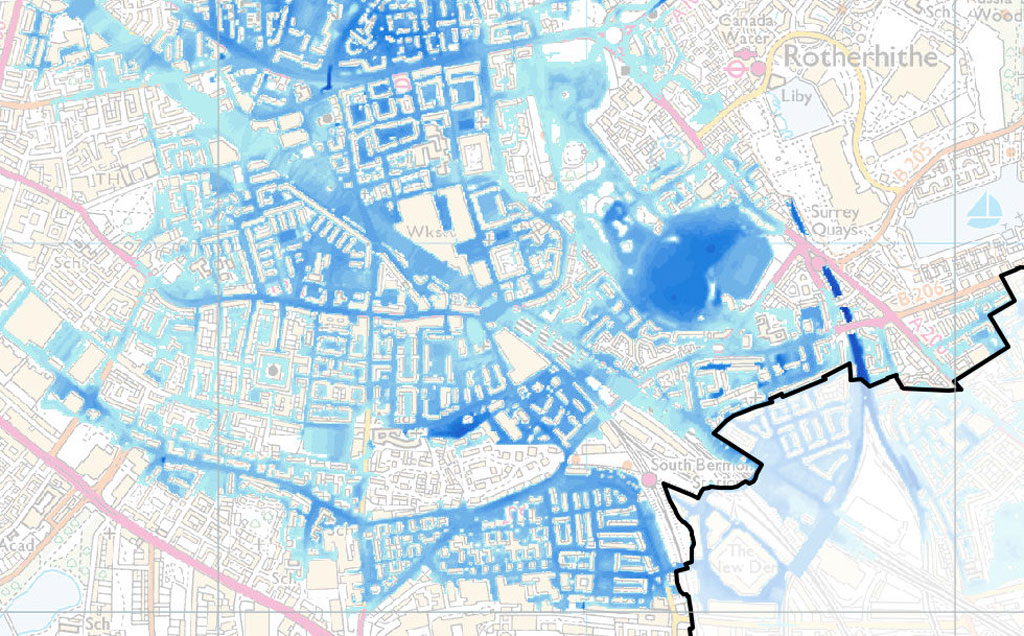Tidewalk
Emergency walkways that carry people across future floodwaters, highlighting London’s vulnerability to rising sea levels.
Photomontage
Mapping from Southwark Council’s Strategic Flood Risk Assessment showing extent of potential flooding in the year 2100 based on rising sea levels and a single berm breach on the Thames. Shade of blue represents projected depth with darker colours representing deeper water
Tidewalk is in an early stage of development. The image to the left is a photomontage.
Sea level rise scenarios combined with river flooding could see large parts of Central London under water in the future, even with the current Thames barrier in place. Based on the current science, large low-lying parts of Westminster, Southwark and Lambeth could be inundated creating temporary islands and peninsulas separated by shallow running reaches of water.
Tidewalk will be an emergency structure from that possible future, physically installed in the present-day city. The proposal is for sections of temporary raised walkways to be built to cross the stretches of water that would exist if these projected sea level scenarios were to occur, allowing people to continue to move about the flooded city on foot.
This art project will create unexpected encounters with the type of structures ordinarily associated with watery environments, amidst the everyday bustle of busy streets and public spaces. This incongruous juxtaposition aims to provoke thought and conversation around sea level rise and wider the climate crisis.
As well as acting as ‘provocations’, the structures will also be participatory artworks that people can walk along and interact with. The aim is to take abstract, scientific data (sea level projections) and convert that in to an embodied experience by physically lifting participants up to a new (formerly abstract) level and literally changing their perspective. By doing this, the project invites the audience to recreate in their imagination the flooded streets below the walkways they are traversing.
Both now and in the future
As a future infrastructure project, Tidewalk would form an extensive network of walkways linking important parts of the city and joining up communities cut off by the flood waters. Local ferries would also stop at jetties connected to the walkways, allowing people to make longer journeys across wider, deeper stretches of water.
As a present-day artwork, foreshadowing that future, Tidewalk will comprise smaller sections of walkway placed ‘as if’ they were part of that bigger future network.
The location and height of each section will be based on current projected sea level scenarios for 2100, and use up to date flood risk mapping. (This mapping takes account of sea level rise, weather conditions and potential breaches of the Thames embankments).
Both art object and functional infrastructure
As a matter of practicality and affordability, Tidewalk will be easily put together and quickly demountable, using inexpensive, easily sourced materials. The structures will also be safe to use in the public realm and comply with relevant regulations. This essentially means that Tidewalk will also become a piece of fully functional infrastructure that could actually be used in real flood situations.
Capitalising on this, Tidewalk will be developed simultaneously as an art project and as a usable disaster relief solution. Designs and assembly instructions would be shared with communities, local authorities and relevant agencies who deal with flooding. This could be deployed, for example, during the increasingly frequent river flood events.
This dual use as art-object and utilitarian object (depending on the context in which it is placed) conceptually reflects the fact that the effects of climate change are simultaneously a present-day reality and (on a larger scale) a projected future.
Both art provocation and functional infrastructure
One or more wider landing stages/jetties would be incorporated that would also act as gathering spaces. Tidewalk might also become a platform or forum for other artists’ interventions, music, food, events, talks etc.
The jetties that form part of Tidewalk might be experienced as ‘points of departure’ literally (in the imagined future where boats arrive and depart in this flooded landscape) and metaphorically, prompting and providing a forum for ongoing discussion.




